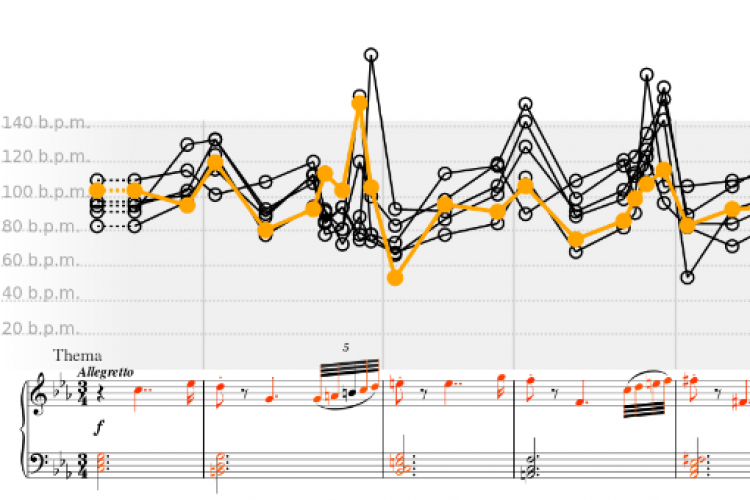In a series of user studies conducted at Vienna’s University of Music and Performing Arts Vienna (mdw), we interviewed piano students to learn about their rehearsal practice, and to better understand the beneficial role that digital tooling could play, in order to inform our development activities.
The first version of CLARA was developed following a pilot study that underlined the utility of using the score as a fine-grained means of navigating and comparing between different rehearsal recordings. This requires the alignment of the different recordings with the musical score at the note-level, and this process also produces metadata that describe specific aspects of each rendition, including the precise timing and dynamics of each performed note.
By comparing the time intervals between successive performed notes with the intervals in score time obtained from our MEI encodings using the Verovio software, we can quantify the tempo of each performed inter-note interval. This information can be visualised as tempo curves, providing an intuitive view of the variations in tempo over the course of different performances.

We presented an updated version of CLARA that includes these tempo curves at ISMIR 2019’s late-breaking demos session (see our abstract and poster). There, we also allowed conference attendees to record their own rehearsal performances on a small MIDI keyboard, an M-Audio Key Station Mini 32. We chose a less challenging composition for this purpose, in order for all conference attendees (including non-pianists) to be able to participate.

The screenshot above shows the tempo curves for all performances gathered from participants in this session. It demonstrates a solid core of 80-120bpm renditions; some stragglers; and a race to the top (400bpm+), as attendees competed to complete ISMIR’s fastest rendition of Twinkle Twinkle Little Star.
Further user study sessions at mdw demonstrating this version of CLARA support the utility of visualised tempo curves in helping pianists reflect on their rehearsal activities. These sessions have also produced requirements for further visualisations, which we have incorporated into our development priorities. These include graphical visualisations of performance dynamics, performance errors, and pedalling positions.
- Inicia la sessió per fer comentaris



